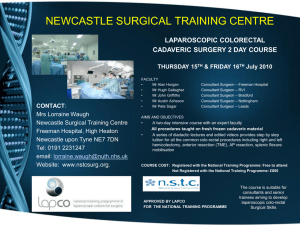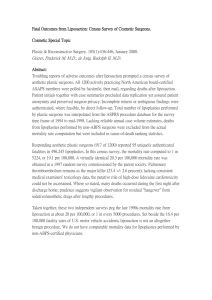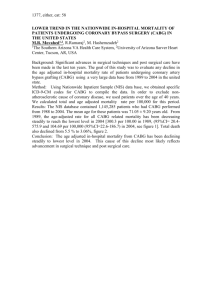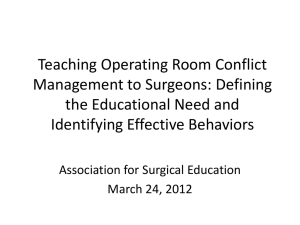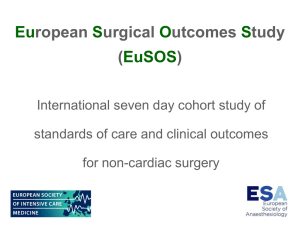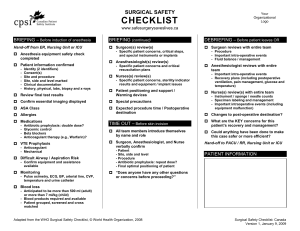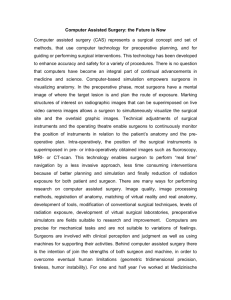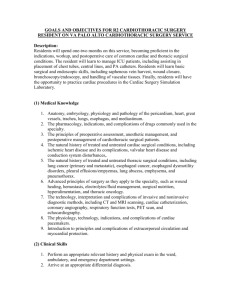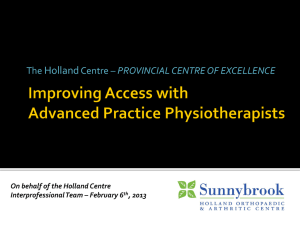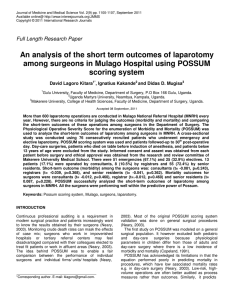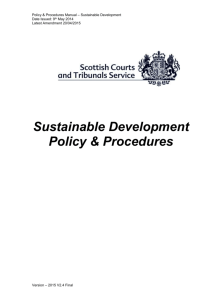monitoring individual and team outcomes and supporting early
advertisement
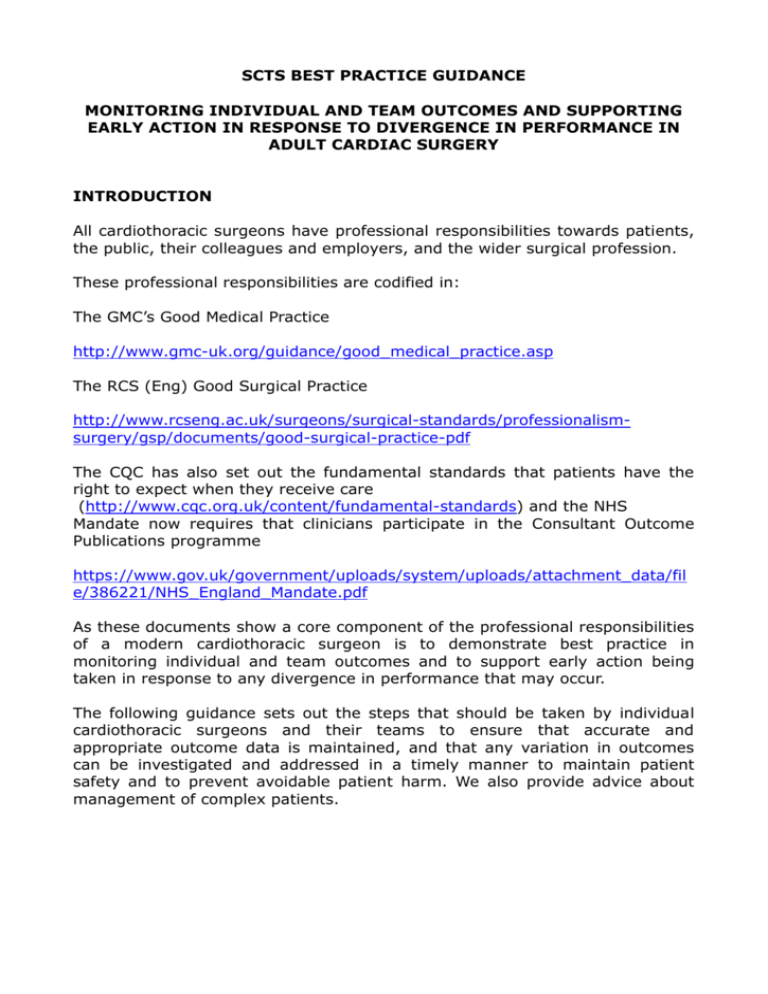
SCTS BEST PRACTICE GUIDANCE MONITORING INDIVIDUAL AND TEAM OUTCOMES AND SUPPORTING EARLY ACTION IN RESPONSE TO DIVERGENCE IN PERFORMANCE IN ADULT CARDIAC SURGERY INTRODUCTION All cardiothoracic surgeons have professional responsibilities towards patients, the public, their colleagues and employers, and the wider surgical profession. These professional responsibilities are codified in: The GMC’s Good Medical Practice http://www.gmc-uk.org/guidance/good_medical_practice.asp The RCS (Eng) Good Surgical Practice http://www.rcseng.ac.uk/surgeons/surgical-standards/professionalismsurgery/gsp/documents/good-surgical-practice-pdf The CQC has also set out the fundamental standards that patients have the right to expect when they receive care (http://www.cqc.org.uk/content/fundamental-standards) and the NHS Mandate now requires that clinicians participate in the Consultant Outcome Publications programme https://www.gov.uk/government/uploads/system/uploads/attachment_data/fil e/386221/NHS_England_Mandate.pdf As these documents show a core component of the professional responsibilities of a modern cardiothoracic surgeon is to demonstrate best practice in monitoring individual and team outcomes and to support early action being taken in response to any divergence in performance that may occur. The following guidance sets out the steps that should be taken by individual cardiothoracic surgeons and their teams to ensure that accurate and appropriate outcome data is maintained, and that any variation in outcomes can be investigated and addressed in a timely manner to maintain patient safety and to prevent avoidable patient harm. We also provide advice about management of complex patients. LOCAL MONITORING OF SURGICAL OUTCOME DATA ACCURACY Data Validation As a minimum a 10% sample of the data points contributing to the logistic EuroSCORE should be validated by an independant observer. Where a discrepancy is found the data inputter and validator should confer to resolve the discrepancy. A written record should be kept to confirm the data validation process that has been completed and any actions that have been taken as a result of this process. LOCAL MONITORING OF SURGICAL OUTCOME DATA CUSUM For each individual surgeon and for the unit overall a contemporary CUSUM plot of observed versus expected mortality should be maintained. The logistic EuroSCORE should be recallibrated using the spreadsheet available here. CUSUM plots should be formally reviewed by the consultant surgeons at least every 3 months to ensure that individual and unit performance is within expected norms and action taken if this is not the case. It is as important to look at trends in observed mortality as well as the difference between observed and predicted mortality. The difference between observed and predicted mortality maybe different when put in the National context. It is therefore important that false reassurance is not taken if the observed mortality is lower than but close to predicted mortality. If you have concerns please contact SCTS for further advice. LOCAL CLINICAL GOVERNANCE ACTIVITY TO REVIEW SURGICAL OUTCOMES ADMINISTRATIVE SUPPORT Different units will have different administrative arrangements to support the internal monitoring of outcomes. However the following principles must apply to these arrangements. An electronic database must be used to record all surgical activity and the SCTS dataset. This database requires a non-clinical administrator to assist the clinical audit lead in managing the data validation and providing CUSUM reports and other reports. There should be non-clinical administrative assistance to support the Euroscore validation and morbidity and mortality meeting by, as a minimum, identifying deaths, recording attendance and outcomes of discussions. MORTALITY AND MORBIDITY MEETINGS A multidisciplinary mortality and morbidity meeting should be held within each unit on a monthly basis. All deaths should be discussed at this meeting. Each death should be presented by an appropriate, independent person using a structured form. The standard of care should be graded by a formal mechanism such as that used by NCEPOD. Overall assessment of care for this patient: 1. Good practice – a standard that you would accept for yourself, your trainees and your institution 2. Room for improvement – aspects of clinical care that could have been better 3. Room for improvement – aspects of organisational care that could have been better 4. Room for improvement – aspects of both clinical and organisational care that could have been better 5. Less than satisfactory – several aspects of clinical and/or organisational care that were well below satisfactory 6. Insufficient information submitted to assess the quality of the care If standard of care is graded as room for improvement the need for further action should be considered. If standard of care is graded less than satisfactory an action plan should be drawn up in conjunction with the Trust's Clinical Governance policies. The structured analysis and grading should be recorded and retained for future reference if necessary. INDIVIDUAL PERFORMANCE APPRAISAL For each death, the operating surgeon should complete a reflection on the case which should form part of their annual appraisal. ACTIONS TO TAKE IF POTENTIAL DIVERGENCE IN PERFORMANCE IS IDENTIFIED If a CUSUM curve shows observed mortality above or approaching predicted mortality the following steps should be taken: ◦ Data should be checked for accuracy. ◦ Mortality discussion forms should be reviewed to identify any common themes. ◦ If present, these should be addressed in line with the Trust’s Clinical Governance policies. ◦ If standard of care has been identified as room for improvement or worse, progress against previously agree action plans should be rigorously assessed. Consideration should be given to accessing external support at an early stage. EXTERNAL SUPPORT SCTS can provide external support in partnership with NICOR, for data issues and RCS(Eng) for clinical issues. RCS(Eng) provides an invited review service that can be offered to surgeons and their Trusts to provide an objective, external, independent and expert review of surgical practice. This service can undertake invited reviews of the practice of an individual surgeon, a surgical service, or a series of clinical records. It can also offer an enhanced clinical record review (including a case based discussion with the surgeon responsible for the care provided) to provide advice where an individual surgeon or their Trust need an expert review of a series of patient deaths that have triggered an “alert” or “alarm” notice under the consultant outcome publication process. Further information about these services and how may be able to help can be provided by the RCS invited review team on 02078696223. The team is also available to provide general advice and guidance on best practice in managing surgical performance. Complex Patients For complex patients decision making about surgery can be difficult. Best practice is for such decisions to be made in a multi-disciplinary forum containing at least two consultant surgeons. Attendance at these meetings and the outcome of the discussion should be formally recorded. Some patients may be best served by having two consultant surgeons at their operation. There are many models for achieving this, the Papworth Star Chamber model is available here.
